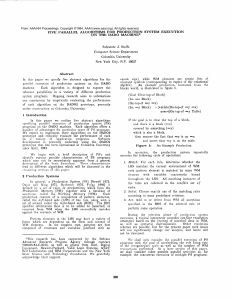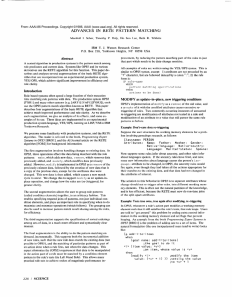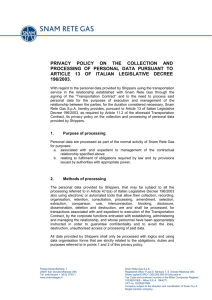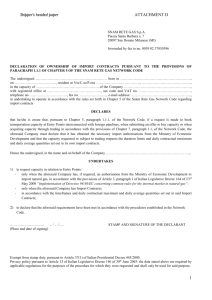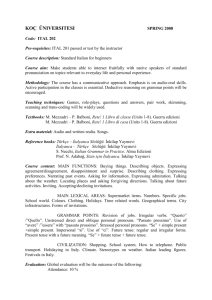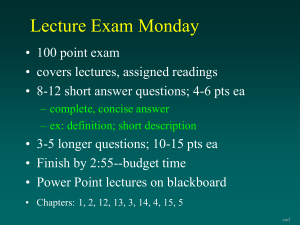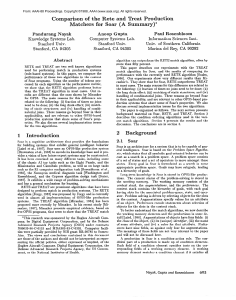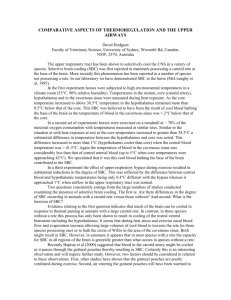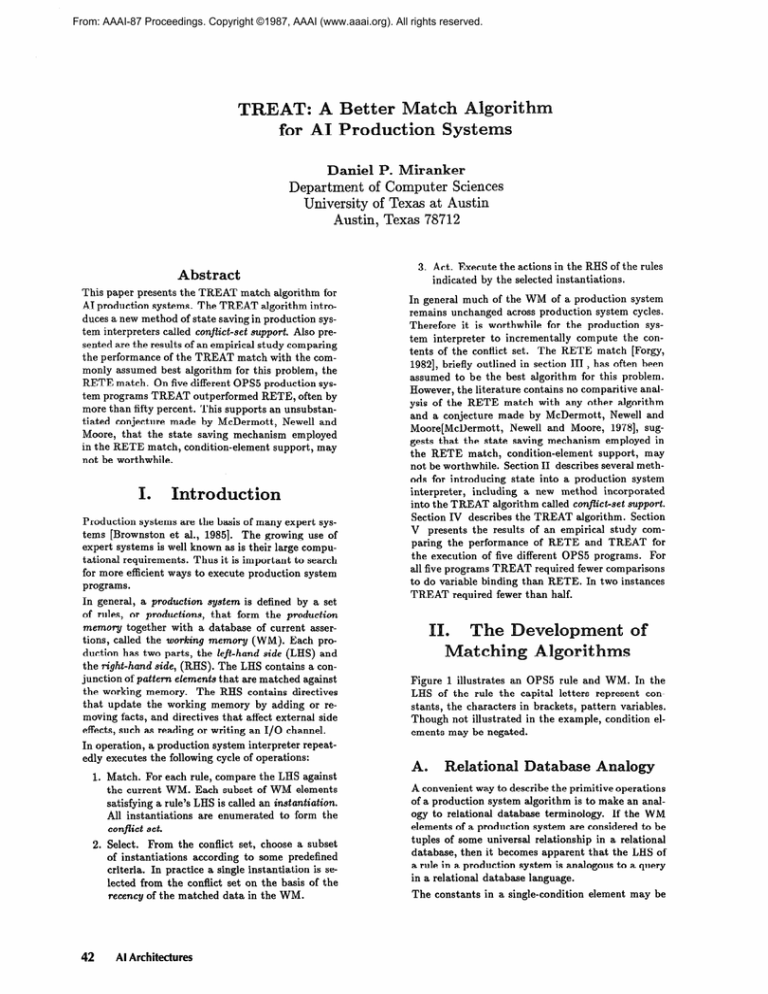
From: AAAI-87 Proceedings. Copyright ©1987, AAAI (www.aaai.org). All rights reserved.
lgorith
T’REAT’: A Better Mate
for AI Production
Systems
Daniel I?. Miranker
Department of Computer Sciences
University of Texas at Austin
Austin, Texas 78712
Abstract
This paper presents the TREAT match algorithm for
AI production systems. The TREAT algorithm introduces a new method of state saving in production system interpreters called conflict-set support. Also presented are the results of an empirical study comparing
the performance of the TREAT match with the commonly assumed best algorithm for this problem, the
RETE match. On five different OPS5 production system programs TREAT outperformed RETE, often by
more than fifty percent. This supports an unsubstantiated conjecture made by McDermott,
Newell and
Moore, that the state saving mechanism employed
in the RETE match, condition-element support, may
not be worthwhile.
I.
Introduction
Production systems are the basis of many expert systems [Brownston et al., 19851. The growing use of
expert systems is well known as is their large computational requirements. Thus it is important to search
for more efficient ways to execute production system
programs.
In general, a production system is defined by a set
of rules, or productions, that form the production
memory together with a database of current assertions, called the work&g memory (WM). Each production has two parts, the left-hand side (LHS) and
the right-hand side, (RHS). The LHS contains a conjunction of pattern elements that are matched against
the working memory. The RHS contains directives
that update the working memory by adding or removing facts, and directives that affect external side
effects, such as reading or writing an I/O channel.
In operation, a production system interpreter repeatedly executes the following cycle of operations:
1. Match. For each rule, compare the LHS against
the current WM. Each subset of WM elements
satisfying a rule’s LHS is called an instantiation.
All instantiations are enumerated to form the
conjlict set.
2. Select. From the conflict set, choose a subset
of instantiations according to some predefined
criteria. In practice a single instantiation is selected from the conflict set on the basis of the
recency of the matched data in the WM.
42
Al Architectures
3. Act. Execute the actions in the RHS of the rules
indicated by the selected instantiations.
In general much of the WM of a production system
remains unchanged across production system cycles.
Therefore it is worthwhile for the production system interpreter to incrementally compute the contents of the conflict set. The RETE match [Forgy,
19821, briefly outlined in section III , has often been
assumed to be the best algorithm for this problem.
However, the literature contains no comparitive analysis of the RETE match with any other algorithm
and a conjecture made by McDermott, Newell and
Moore[McDermott,
Newell and Moore, 19781, suggests that the state saving mechanism employed in
the RETE match, condition-element
support, may
not be worthwhile. Section II describes several methods for introducing state into a production system
interpreter, including a new method incorporated
into the TREAT algorithm called conflict-set support.
Section IV describes the TREAT algorithm. Section
V presents the results of an empirical study comparing the performance of RETE and TREAT for
the execution of five different OPS5 programs. For
all five programs TREAT required fewer comparisons
to do variable binding than RETE. In two instances
TREAT required fewer than half.
Figure 1 illustrates an OPS5 rule and WM. In the
LHS of the rule the capital letters represent constants, the characters in brackets, pattern variables.
Though not illustrated in the example, condition elements may be negated.
A.
Relationd
atabase Analogy
A convenient way to describe the primitive operations
of a production system algorithm is to make an analogy to relational database terminology.
If the WM
elements of a production system are considered to be
tuples of some universal relationship in a relational
database, then it becomes apparent that the LHS of
a rule in a production system is analogous to a query
in a relational database language.
The constants
in a single-condition
element may be
Rule:
Initial Working Memory:
(P example-rule
(A < x >)
(B<z><y>)
(A 1)
(B 12)
P 2 3)
(C < Y >>
->
; no RHS actions)
Figure
I:
23;)
F
2)
1: Example
McDermott,
Newell and Moore conjected that the
cost of maintaining the state required for condition
relationship exceeds the cost of the comparisons that
otherwise would have to be recomputed.
“It seems highly likely that for many
production systems, the retesting cost will
be less than the cost of maintaining the
network of sufficient tests.“[McDermott,
Newell and Moore, 1978]
Rule System
traducing
State
A difference between database systems and production systems is that database systems usually compute queries one at a time over a large database. In
terms of the analogy, a production system continuously computes many queries, as many as there are
rules, over a slowly changing, modest size database.
To minimize recalculating comparisons on different
production system cycles production systems algorithms retain state across cycles. McDermott, Newell
Newell and Moore, 19781
and Moore [McDermott,
have identified three types of knowledge or state information that may be incorporated into a production
system algorithm. A fourth type, conflict-set support
is exploited by the TREAT algorithm. In detail these
are:
e Condition Membership: Associated with each
condition element in the production system is a
running count indicating the number of WM elements partially matching the condition element.
A match algorithm that uses condition membership may ignore those rules that are inactive. A
rule is active when all of its positive condition
elements are partially satisfied.
a Memory Support: An indexing scheme indicates
precisely which subset of WM partially matches
each condition element.
By analogy, memory
support systems explicitly maintain a represen.tation of the relations resulting from the select
Later this representation will be
operations.
called an alpha-memory.
Q Condition Relationship:
about the interaction
of
within a rule. By analogy
explicitly maintaining the
of a multiway join.
ermott et al.‘s conjecture
cl.
viewed as a relational selection over a database of
WM. We say a WM element partially matches a condition element if it satisfies the select operators or
the intra-condition element pattern contraints. Consistent bindings of pattern variables between distinct
condition elements may be regarded as a database
join operation on the relations formed by the selections. The conflict set is the union of the query results
of each of the rules in the system.
e
By doing so, it is possible to limit the search for
new instantiations to those instantiations that
contain newly asserted WM elements.
Provides knowledge
condition elements
this corresponds to
intermediate results
B Conflict Set Support: The conflict set is explicitly retained across production system cycles.
0
or it
The RETE match[Forgy, 19821 incorporates memory
support and condition relationship.
Until now, no
work has been done to repudiate or confirm McDermott et. al.‘s conjecture.
Despite that conjecture
and a lack of any comparative studies of the RETE
match with any other production system algorithm,
the RETE match is commonly assumed to be the best
algorithm for production system matching.
Briefly, the RETE algorithm compiles the LHSs of
the production rules into a discrimination network in
the form of an augmented dataflow network. (See
Figure 2.) Database operators are used as the operators in the dataflow network. The top portion of the
RETE network contains chains of tests that perform
the select operations. Tokens passing through those
chains partially match a particular condition element
and are stored in alpha-memory nodes, thus forming
the memory support part of the algorithm. Following
the alpha-memories are two-input test nodes that test
for consistent variable bindings between condition elements. By analogy, the two-input nodes incrementally compute the join of the memories on their input
arcs. When a token enters a two-input node, it is
compared against the tokens in the memory on the
opposite arc. Paired tokens with consistent variable
bindings are stored in beta-memories. Tokens that
propagate from the last beta-memory in the network
reflect changes to the conflict set. The reader is encouraged to see [Miranker, 1987b] for a more detailed
explaination.
A.
de0
in
The advantages of RETE are; the large amount of
stored state minimizes the number of times two WM
elements will be repeatedly compared and similar
rules will compile to similar networks, allowing sharing of network structures.
The primary disadvantage of RETE is that when a
WM element is removed the stored state must be unoften requiring the repetition of the precise seof operations that were performed upon its addition. Other disadvantages are; the size of the betamemories may be combinatorially explosive, sharing
A&ranker
43
condition elements.
The cases concerning positive
condition elements remain unchanged from the previous section. The handling of negated condition elements is described in the abstract algorithm and in
detail in [Miranker, 1987b]. Briefly, in the other two
cases when changed elements partially match negated
condition elements the condition is temporarily considered to be positive and the change acts as a seed
to create possible instantiations. If the change is an
addition, instantiations are removed from the conflict
set. If the change is a deletion, instantiation may be
entered into the conflict set.
C.
Figure
2: RETE Illustration
network structure is not advantagous in a parallel
environment due to contention and/or communication costs, to maintain consistent state in the network RETE must perform extensive computation for
rules that are inactive, thus not exploiting condition
support.
The incentive to develop TREAT was created by the
difficulties associated with using RETE on parallel
computers. [Stolfo and Miranker, 1984, Gupta, 19841.
In a sequential computer RETE tokens may be manipulated by simple memory accesses. In a parallel
computer manipulating tokens can involve contention
and costly communication steps.
IV.
A.
The T
EAT
Algorithm
Conflict Set Support
To exploit conflict set support two observations must
be made. Assume for the moment that there are no
negated condition elements in the production system.
If the only action of a fired rule is to add a new WM
element, then the conflict set remains the same except
for the addition of new instantiations that contain
the new WM element. In the example below, adding
(A 2) results only in instantiations containing (A 2).
The second observation is that if the only action of
a fired rule is to delete a WM element, then no new
rules will be instantiated.
Some instantiations may
become invalide. These will contain the removed WM
element.
The essence of the TREAT algorithm is to exploit
these observations.
Additions to WM may be used
as seeds to initiate a constrained search for new instantiations.
Deletions are processed by examining
the conflict set directly and removing any instantiation that contain a deleted WM element. (See Figure
4.1
B.
Negated Condition Elements
Allowing negated condition elements slightly complicates the algorithm.
The TREAT algorithm must
consider four cases, the addition or deletion of WM elements that partially match both positive or negated
44
Al Architectures
Detailed TREAT
Algorithm
The TREAT algorithm exploits condition membership, memory support and conflict set support. All
the condition elements in a production system are
numbered.
The number associated with a condition element is called the condition element number (CE-num). Information relevant to condition elements is stored in arrays indexed by CE-num. Alphamemories similar to those used in RETE are used to
form the memory support part of the algorithm, but
rather than existing amorphously in a network they
are formed explicitly as a vector, each entry containing an alpha-memory.
The alpha-memories are broken into three partitions: old, new-delete and newadd.l
The old partition, (old-mem),
contains the
partially-matched
elements that have already been
processed.
During the act phase, elements are not
added to the old-mem but to the memories in the add
and delete partitions, (new-add-mem and new-delmem). The calculation of the contents of the alphamemory could be done by building the top portion of
a RETE network. The implementation reported here
used a hash function whose argument is the value of
the first attribute in an OPS5 WM element.
To incorporate condition support, whenever an oldmem is updated a test is made to see if its size has
become zero or nonzero. If the critical change is detected, the size of each of the old-mems for the rule
is examined and the set of active rules is updated
accordingly.
When an alpha-memory of an active rule is altered
and the change corresponds to one of the three cases
where a search for instantiations is required, then the
search takes place among the changed (new) alphamemory, the old-memories that correspond to the remaining condition elements in the rule. Figure 3 contains an abstract program for the TREAT algorithm.
D.
Join Optimization
The join operation is commutative and associative.
Thus when searching for consistent variable bindings
the alpha-memories may be considered in any order.
There are many multiway join optimizations[Ullman,
lIn the implementations reported here, these are formed by three
separate vectors. However, a vector of structures would probably
have resulted in better paging characteristics.
1. Act: Set CHANGES
RHS.
to the WM updates required by the
2. For each WM change in CHANGES
do;
(a) For each condition element, CEi do;
e If the partial match of the element against CEi is
successful
and if addition to working memory
then add WM-element to new-add-mem[CEi].
else add WM-element to new-del-mem[CEi].
end for;
end for;
Match:
Process deletes.
For each nonempty del-mem do;
(4 Set
04 Set
(4
(4
cur-ce = CE-num of the selected memory.
old-mem[cur-ce]
= old-mem[cur-ce]
- new-delmem[cur-ce].
If size of old-mem[cur-ce] = 0 then update-rule-active.
Case: If CE corresponding
itive or negated.
.
1.
to the new-del-mem is pos-
Positive: Search conflict set for instantiations containing the deleted WM-elements.
If found remove
them.
ii. Negative: If the affected rule is active, then perform
search for new instantiations by searching new-delmem[cur-ce] and the old-mems that correspond to
the remaining condition elements that are part of
the affected rule. Check that the new instantiations
are not invalidated by elements in old-mem[cur-ce].
end for;
Q. Match:
Process adds.
6. For each nonempty add-mem do;
cur-ce = CE-num of the selected memory.
old-size = the size of old-mem[cur-ce].
= old-mem[cur-ce]
+ addold-mem[cur-ce]
mem[cur-ce].
If size of old-mem[cur-ce] = 0 then update-rule-active.
(4 Set
(b) Set
(4 Set
(4
(4
If the rule is active, then perform search for new instantiations by searching new-add-mem[cur-ce]
and the
old-mems that correspond to the CEs of the remaining
CEs that are part of the affected rule.
(f1 Case:
If CE corresponding
of negated.
to the del-mem is positive
i. Positive: Add these new instantiations to the conflict set
ii. Negative: Search the conflict set for each of the new
instantiations and remove them if found.
end for;
Figure 3: Abstract Algorithm Illustrating TREAT
Figure 4: TREAT Illustration
19821. However, in OPS5 the small size of the alphamemories and the very small number of WM changes
per cycle, (an average of 2.5), dictates that for an optimization to be useful it must be simple to compute
and result in a deterministic ordering of the alphaThree orderings were studied.
Staticmemories.
ordering, where the alpha-memories where considered in the lexical order of condition elements. Seedordering, where the changed alpha-memory is considered first, since in OPS5 these changes are almost
always small and considering them first will greatly
constrain the search. The third method based on
semi-join reductions was not successful and will not
be detailed. Note that the use of join optmizations
allows TREAT to be used effectively for other production system languages. If a system is temporallynonredundant the search for instantiations may still
be performed in a different but still optimal order.
Miran ker
45
E,
An Example using TREAT’
Figure 4 shows the initial state created by the
TREAT algorithm as well as the activity during the
addition and deletion of a WM element (A 2). The
activities of TREAT and RETE in this case are identical except that TREAT does not maintain betamemories. However, the beta-memories do not contribute constructively to the computation of the new
instantiation. To be fair, note that for the add example had the WM element partially matched the “C”
branch of the network RETE would have searched
only a beta-memory while TREAT would have had
to search both remaining alpha-memories.
For a
delete, the RETE match must recompute the tokens
stored in the beta-memories and then delete them.
TREAT outperforms RETE during deletetions by directly updating the alpha-memories and the conflictset. The key issue is; does the number extra comparisons performed by TREAT while searching for instantiations exceed the number of comparisons performed by RETE while processing deletions?
The
results of an empirical study of this question are presented in the next section.
EAT
v.
vs.
ETE
This section presents quantitative measurements of
identical runs of OPS5 programs on several different OPS5 interpreters. The RETE-based
OPS5 interpreter is the familiar one distributed by Forgy
from Carnegie Mellon University. The TREAT-based
OPS5 interpreters were written at Columbia University.
A.
Synogsis
of
the
Five OPS5 programs representing a wide variety of
characteristics were obtained from diverse sources.
Some characteristics of these systems are summarized
in Figure 5.
MAB: The familiar Monkeys and Bananas program[Brownston et al., 19851.
Waltz: A set of rules that perform Waltz constraint propagation[Winston,
19791.
Mapper: The Mapper is program that will assist
a tourist to navigate Manhattan’s public transportation system. The Mapper has an extremely
large WM. The maps for nearly the entire Manhattan bus and subway systems are stored as
1124 WM elements.
Mud: A system written at Carnegie Mellon University to to analyze the castings from oil wells.
It should also be noted that this is precisely the
same system used by Gupta [Gupta, 19861 in his
study of parallelism in OPS5.
Mesgen: A natural-language program written by
Karen Kukich at the Univ. of Pennsylvania that
takes Dow Jones figures and converts them into
text describing the course of a trading day.
Al Architectures
Number
of
rules
MAB
13
884
Mud
Waltz
33
Mesgen 155
Mapper 237
Figure
Studied
5:
Number
of
conditions
34
2134
130
442
771
Summary
Average
WM
Size
11
241
42
34
1153
of the Gross
Cycles
in test
run
14
972
71
138
84
Characteristics
Average
cs
Size
21
193
149
595
of the
Systems
Comparisons
counting
El.
Variable Bindings
hs
It has been reported that 90% of the execution time
of a production system is spent in the match phase.
Evidence indicates that in the RETE-OPS5
implementation the majority of the match time is spent in
performing variable binding and in maintaining the
beta-memory nodes [Gupta, 19861. The critical difference between the algorithms is the method used to
handle variable binding.
The graphs in Figure 6 show the number of comparisons required to do variable binding for each of the
OPS5 programs for two variations of each algorithm.
The bars are normalized to the number of comparisons required by execution of the stardard RETE
The dark portion of the bars inimplementation.
dicates the number of comparisons required during
the add cycles, the light portion, the number for the
delete cycles.
The RS bars represent the performance of the standard release of RETE-based
OPS5.
The RN bars
indicate the performance of RETE without sharing.
We see that sharing does not contribute significantly,
if at all, to the variable binding phase of the RETE
match.
The TN bars represent the performance of TREAT
without any optimizations.
Search is performed in
lexical order. Depending on the system this version
of algorithm may perform better or worse than the
RETE match. Thus, some run-time optimization is
necessary.
The TO bars represent the performance of TREAT
using the seed-ordering heuristic. Inspection of the
graphs shows that TREAT with seed-ordering always
performed better than RETE even on a sequential
computer.
Except for the Mapper2 with it’s very
large WM the algorithm requires roughly half of the
comparisons required of the RETE match. Note for
each successful comparison performed by the RETE
match there is the additional expense of maintaining
a beta-memory.
2There is evidence that with the introduction of hashing the performance of the Mapper would be closer to that of the other systems
In many cases TREAT without any optimization outperforms the RETE match. With seed-ordering optimization, TREAT always outperforms RETE. In two
intances TREAT required less than half of the comparisons to perform variable bindings than RETE.
This does not consider the additional cost of maintaining the beta-memories.
Since the algorithms are
nearly identical in all other respects, it may be concluded that TREAT is a better production system
algorithm in both time and space. Further this study
supports the conjecture made by McDermott, Newell
and Moore that condition-element support many not
be worthwhile.
[Brownston et al., 19851 L. Brownston, R. Farrell, E.
Kant, and N. Martin. Programming Expert Systems in OPS5. Addison Wesley, Reading, Mass.,
1985.
[Forgy, 19821 Charles L. Forgy. Rete: A Fast Algorithm for the Many Pattern/Many
Object Patern Matching Problem. Artificial Intelligence,
19:17-37, 1982.
[Gupta, 19841 Anoop Gupta.
Implementing OPS5
Production Systems on DAD0
In Proceedings
International Conference on Parallel Processing,
IEEE Computer Society Press, 1984.
[Gupta, 19861 A noop Gupta. Parallelism in Production Systems.
Ph.D. Thesis.
Carnegie Mellon University, Department of Computer Science
1986.
TREAT:A
[Miranker, 1987a] Daniel P. Miranker.
Better Match Algorithm for AI Production Systems; Long Version. Technical Report, Department of Computer Sciences, University of Texas
at Austin, April 1987.
TREAT:A
[Miranker, 1987b] Daniel P. Miranker.
New and Ieficient Match Algorithm for AI Production Systems Ph.D. Thesis, Computer Science Dept. Columbia University. Available as
Technical Report TR-87-03, Dept. of Computer
Sciences, University of Texas at Austin, Jan.
1987.
[Stolfo and Miranker, 19841 Salvatore J. Stolfo and
Daniel P. Miranker. DADO:A Parallel Processor for Expert Systems. In Proceedings International Conference on Parallel Processing. IEEE
Computer Society Press, 1984.
[Ullman, 19821 J.D. Ullman. Principles of Database
Systems. Computer Science Press, 1982.
[McDermott, Newell and Moore, 19781
J. McDermott,
A. Newell and J. Moore.
The
Efficiency of Certain Production System Implementations.
In Pattern-directed Inference Systems. Academic Press, 1978.
Artificial
[Winston, 19791 P. II. Winston.
gence. Addison Wesley, 1979.
Intelli-
A&ranker
47

